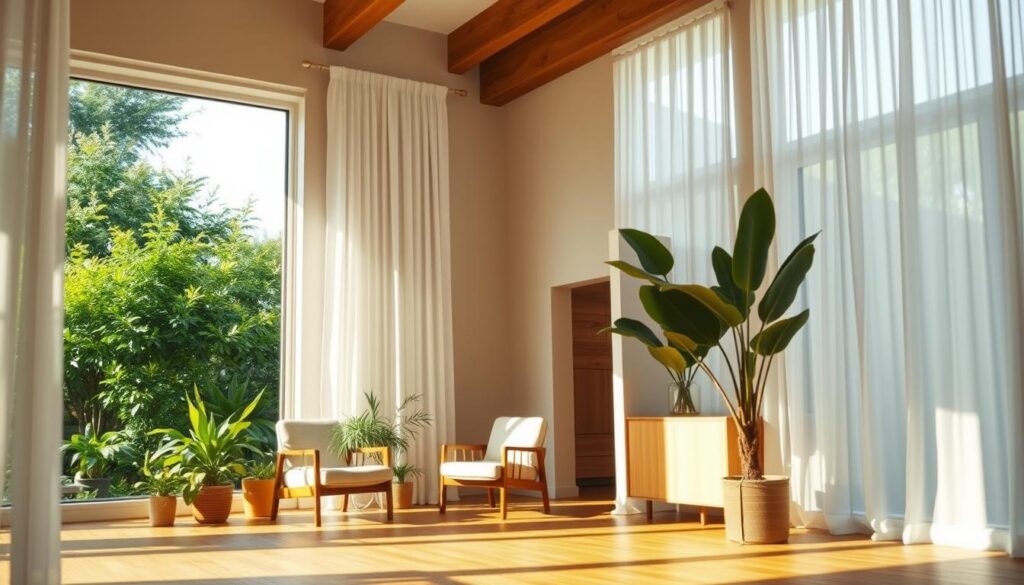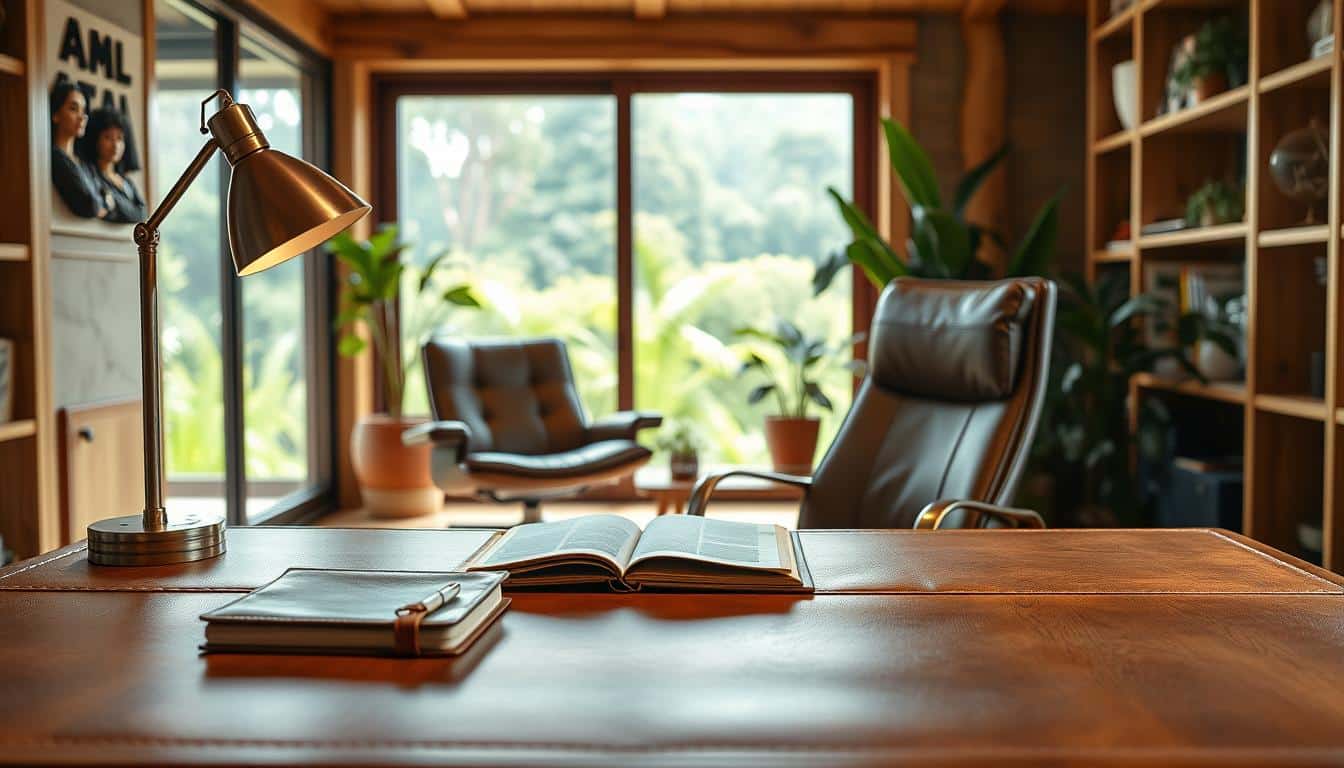Today, using biophilic materials in our spaces is key for true comfort. This approach is all about bringing nature into design. It helps make our interiors comfy and boosts our well-being. We’ll see how using nature in our spaces makes them calm and peaceful.
Linking with nature makes our homes and work areas better places to be. Let’s dive into biophilic design. See how it changes our living environments.
Understanding Biophilic Design
Biophilic design blends nature into our living spaces, helping us feel closer to the natural world. It makes places where we live and work feel more calming, boosting our happiness and how well we work. This idea comes from understanding that being around nature’s vibe is good for us.
Definition and Concept
This design approach brings the outdoors inside in a smooth way. It builds on our deep need to be around nature, which goes back to ideas proposed by thinker Erich Fromm. It shows us how smart design can reconnect us with nature in our modern buildings.
Historical Context and Development
Looking back, biophilic design has its roots in old building ways that included nature’s touch. But as cities grew, these natural elements were often left out. Now, with a bigger push for green living, there’s a comeback of these nature-friendly designs in our urban areas.

The Importance of Connection to Nature
Urban life changes how we interact with our surroundings. In cities, people often feel a disconnect from nature. This can lead to more stress and health problems related to the environment.
Feeling distant from nature is a mental health challenge. It’s important to look at how city living affects our happiness.
Effects of Urbanization on Well-being
Urbanization deeply affects our happiness. City folks might not get enough nature time. This can make them more anxious or depressed.
The quick pace of city life might make people feel lonely and stressed. As cities expand, including green spaces is key to a healthier life.
Research Findings Post-COVID-19
COVID-19 made us focus more on mental health and the value of connecting with nature. Lockdowns made indoor life common, boosting the demand for mental health help.
Studies found people felt better emotionally when they connected with nature during the pandemic. This included virtual tours or gardening. It shows we need nature in our cities for better health.
Benefits of Biophilic Materials
Biophilic materials greatly boost people’s well-being. They offer psychological and physiological benefits from nature. This promotes mental and physical health, making us more comfortable and happy.
Psychological Advantages
Adding biophilic elements to our spaces helps us mentally. Natural elements can lower stress, help us relax, and boost creativity. Seeing greenery and natural materials makes us feel better and encourages us to connect with others.
Physiological Health Outcomes
Biophilic materials are also good for our physical health. Sunlight and fresh air boost our immune system and make us less tired. People in such environments tend to have fewer health problems and feel more alive.
Impact on Mood and Productivity
Nature in our workplaces and homes improves how much we can do. It helps our brain work better, making it easier to pay attention and stay focused. Feeling close to nature not only sparks creativity but also makes work feel more rewarding, adding comfort to our daily lives.
Comfort Optimization Through Biophilic Materials
Making living spaces comfy involves bringing in elements from nature. Installing big windows helps to not only make the space look better but also makes people feel good emotionally. Fresh air moves through rooms easily thanks to smart ventilation, making the space feel lively and fresh.
Direct Contact with Natural Elements
Using natural elements in our homes helps us connect with the outdoors. Things like indoor plants, water features, and using natural materials can make a place feel cozy. Being close to nature can make us feel less stressed and more joyful.
Incorporating Natural Light and Ventilation
Putting windows in the right places can fill a room with sunlight, which is good for our mood and energy. Good ventilation helps keep the air fresh, which is important for a healthy and comfy home. This mix of light and fresh air is key for feeling good and being productive.
Effective Strategies for Integrating Biophilic Design
Adding biophilic strategies to your space brings you closer to nature. It makes your surroundings better for your comfort and health. This approach focuses on letting in more sunlight and bringing indoor plants into homes, making spaces live and welcoming.
Maximizing Daylight in Living Spaces
Natural daylight is key to making any room feel better. By placing windows carefully, you can let more sunlight in, making rooms feel spacious and fresh. This not only boosts your mood but also helps your body clock, making you feel at ease.
To get more daylight, consider these tips:
- Install windows to catch the most light.
- Reflect light deeper into the room with mirrors.
- Add skylights where you need extra sunlight.
Incorporating Indoor Plants and Greenery
Adding plants indoors is a great move for both looks and health. Plants make your space more inviting and clean the air, supporting a healthier living area. To easily include plants in your design, follow these suggestions:
- Choose plants that are easy to look after.
- Set aside areas for plants to improve focus and relaxation.
- Try vertical gardens to save space and still have plants.
Natural Materials and Their Role in Comfort
Choosing natural materials is key to comfy biophilic designs. They like wood and stone not only anchor us to Earth but also make our living spaces healthier. These materials help purify the air by releasing fewer harmful compounds.
As we aim to merge our homes with nature, wood and stone become the go-to materials.
Options for Sustainable Materials
Looking for sustainable materials? Here are some great choices:
- Wood: It’s not just strong, but also looks beautiful.
- Bamboo: It grows back fast, making it a green pick.
- Cork: This material keeps homes warm and is sourced renewably.
Benefits of Using Wood and Stone
Wood and stone make our homes feel calm. Here’s how they help:
- They naturally keep temperatures comfortable.
- These materials absorb sound, leading to quieter spaces.
- The look and feel of wood and stone connect us to nature, helping us relax.
Creating Spaces that Encourage Relaxation
Designing spaces for relaxation is key to improving our well-being. It’s essential to create cozy areas that offer a break from stress. By following biophilic design principles, we can craft spaces filled with peace and safety. Natural elements play a big role in these designs.
Designing Comfortable Nooks and Refuge Spaces
Spaces must make us want to stay and recharge. Placing furniture like comfy armchairs or soft pillows helps create a safe vibe. Perfect spots can have:
- Reading corners with lots of sunlight
- Spaces with soft fabrics and warm hues
- Quiet areas packed with indoor greenery
These special spots provide an escape from our busy lives, helping us relax and find serenity.
The Role of Indoor Scenery
The view inside matters a lot for relaxation. Seeing plants and natural scenes can make any space calming. We can add:
- Big windows that show the outdoors
- Indoor gardens to feel like outside is inside
- Natural-themed art or decorations
Connecting with nature this way brings peace and helps us be present. Designing with these ideas in mind supports our emotional and mental health.
Adapting Biophilic Design for Different Environments
Understanding biophilic design means knowing how urban and rural areas differ. In cities, designs feature vertical gardens, green roofs, and indoor plants. This helps people feel close to nature even in small spaces. Rural designs, however, use wide-open landscapes. They focus on natural views and enjoying the outdoors.
Urban vs. Rural Applications
In cities, biophilic design aims to increase nature contact by:
- Rooftop gardens that add more greenery
- Building exteriors using natural materials
- Indoor plants for better air and looks
In the countryside, the design uses the land by:
- Creating outdoor areas for exploration
- Using the landscape for cooling
- Putting in big windows for wide views
Case Studies of Successful Implementations
Many examples show biophilic design working well in both areas. Urban places have apartment complexes with community gardens. These gardens help people meet and connect. Rural homes are made to fit right into nature. Each example shows how biophilic design changes places. It makes living better for everyone.
Conclusion
Using biophilic design makes living spaces more comfortable. By bringing nature closer, we improve the look and feel of our homes. This also boosts our mental and physical health.
This trend shows we realize the impact of our surroundings. Our homes and offices can help nurture us. More and more, we’re choosing natural elements to make spaces feel better.
Looking ahead, design will focus on health and happiness. Biophilic design is key for making healthier homes everywhere. It’s important for our well-being to connect our spaces with nature.
By choosing biophilic design, we do more than decorate. We make our lives better. The push for sustainable living highlights biophilic design’s role. It helps us live more comfortably and in harmony with our environment.



